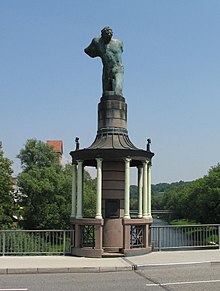Léon Krier

Léon Krier (born April 7, 1946 in Luxembourg ) is an architect , architectural theorist and urban planner from Luxembourg. He is one of the most important representatives of the neo-rationalist and neoclassical architecture of the late 20th century, above all through his provocative theoretical contributions on the subject of urban development and planning. His brother Rob Krier is also an important architect of postmodern and new classical architecture .
Live and act


Léon Krier began studying architecture at the University of Stuttgart and later worked with James Stirling (1968–70) and Josef Paul Kleihues (1973–74), among others . He has been self-employed since 1974. He collaborates on publications with the historicist architect Demetri Porphyrios . Krier calls for a departure from the principles of modernist architecture and modernist urban planning. In the classicist building tradition, as it was formulated up to around 1830, he sees timeless models also for current building. However, the elements of the building ensemble, which used to be symmetrically and hierarchically structured, should be able to be used individually and freely. In particular, Krier turns against industrialized, capitalistically determined building, in which he sees a reason for the increasing ugliness of the world. In contrast, he assumes a handcraft-oriented, artistic architecture concept. Krier's architectural criticism is thus part of a comprehensive, conservative cultural criticism.
Krier presented many large-scale urban plans that were worked out as ideal drafts. He used less and less planning methods of neorationalism, but developed in the direction of neoclassicism . As a theoretician of urban planning, Krier attacks the modernist dogma of dividing the city into functional zones, as advocated by the CIAM . Together with Maurice Culot, Krier was the spokesman for the protests against Brusselsization in the 1980s and in 1982 founded the Prix Européene d'Architecture Philippe Rotthier. In particular, he opposes the American-style urban areas (highly dense business center with rampant suburbs) and calls for a city with a motif, typology and function that is mixed and moderately dense. It is based on the European city of the 18th and 19th centuries. Utopian architecture is Krier's Atlantis project for Tenerife .
Works (architecture and urban development)
- Poundbury , a model village in the south-west of England's county of Dorset, which goes back to the initiative of Prince Charles and is one of the well-known European examples of " New Urbanism ". Here Krier is responsible for the master plan and design guidelines.
- House in Seaside (Florida) , a small seaside resort that is considered one of the prime examples of " New Urbanism ".
- Bridge pavilion in Pforzheim , together with his brother Rob Krier
Awards
- Berlin Architecture Prize, 1977
- Jefferson Memorial Gold Medal, 1985
- Chicago American Institute of Architects Award, 1987
- European Culture Prize, 1995
- Silver medal from the Académie Française for his book Choice or Fate, 1997
- Driehaus Architecture Prize for Classical Architecture, 2003
- Commander of the Royal Victorian Order , 2017
Individual evidence
- ^ Prix Européene d'architecture Philippe Rotthier. (No longer available online.) 1982, formerly in the original ; Retrieved May 18, 2017 (French, English). ( Page no longer available , search in web archives ) Info: The link was automatically marked as defective. Please check the link according to the instructions and then remove this notice.
literature
- Johann-Karl Schmidt : Leon Krier - Atlantis. Cantz, Stuttgart 1988, ISBN 3-922608-96-5 . (Gallery of the City of Stuttgart, published on the occasion of the exhibition of the same name from February 27 to March 13, 1988)
Web links
- Film interview with Léon Krier in: World Capital Germania . Historical documentation by Artem Demenok, 2005, 52 minutes
- Rainer Haubrich: “Leon Krier is 70. Albert Speer? That was good architecture ” , Die Welt, April 7, 2016
| personal data | |
|---|---|
| SURNAME | Krier, Léon |
| ALTERNATIVE NAMES | Krier, Leon |
| BRIEF DESCRIPTION | Luxembourgish architect and urban planner |
| DATE OF BIRTH | April 7, 1946 |
| PLACE OF BIRTH | Luxembourg |